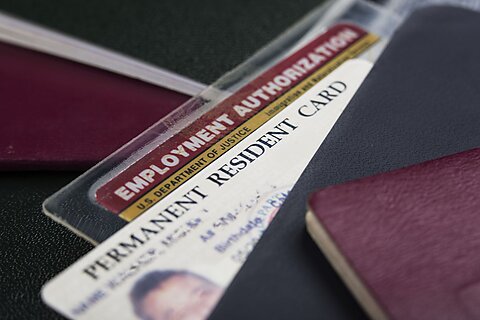Immigrant workers seeking a green card—which denotes legal permanent residence in the United States—now face almost a three-and-a-half-year wait to make it through the government’s regulatory morass. Paying a $2,805 fee could reduce this wait to “only” 2.8 years. Since 2016, the government has added over 18 months to the average green card process. This needs to change to keep America competitive.
The processing delays come on top of the time to wait for a green card cap slot to become available under the annual green card caps (which is often many years). They also don’t include the time spent complying with regulations prior to the first filing step. This prefiling period can take months.
Total green card processing times
- 2025 Regular Processing Time (end Q2): 1,256 days / 41.3 months / 3.44 years
- If paying $2,805 premium processing fee: 1,037 days / 34.1 months / 2.8 years
- 2016 Regular Processing Time: 705 days, 23 months, 1.9 years
- If paying $2,500 premium processing fee: 567 days, 19 months, 1.6 years
Stages of Green Card Processing
Most employer-sponsored immigrants undergo a six-part series of bureaucratic steps. Employers initiate the process, but the employee must participate in each stage.
- Prefiling stage: This stage requires the applicant and employer to gather the necessary documents to prove their eligibility for a green card. This includes proof of degrees, the employer’s ability to pay, and work experience letters. These letters must contain detailed information about the employee’s job duties and tenure, and there is no particular reason why a past employer would want to provide this information.
- 2025 Q2 Time: The public has effectively no information about how long this stage will take. Attorneys say it could take anywhere from a few weeks to several months.
- Prevailing wage determination: The Department of Labor evaluates the job duties, skill requirements, and location of the job to assign a specific occupational classification, skill level, and area code. Based on these factors, DOL uses its Online Wage Library to issue a prevailing wage determination. The average wait for the prevailing wage has nearly tripled since 2016.
- 2025 Q2 Time: 187 days 6.1 months
- 2016 Time: 76 days, 2.5 months
- US Worker Recruitment: Under DOL regulations, employers must also recruit US workers through a specified process that involves multiple newspaper advertisements. They must interview applicants whose resumés meet the “basic” criteria, even if they do not meet all the criteria.
- 2025 Q2 Time: 141 days, 4.6 months
- 2016 Time: 131 days, 4 months
- Labor certification: Employers must then apply for a labor certification from the DOL, certifying that no “minimally” qualified US worker responded to the job advertisements and that the employer did the required steps.
- 2025 Q2 Time: 483.4 days, 15.9 months, 1.3 years
- 2016 Time: 180 days, 6 months
- Employer petition: Employers must then file a petition with the Department of Homeland Security (DHS). DHS will verify that the worker is qualified for sponsorship and confirm the employer’s ability to pay. This is one of the few procedures where employers can pay to skip the waiting. The regulations allow an employer to pay a $2,805 fee (compared to $715 normally) to receive a response in 15 days (unless the government wants additional information).
- 2025 Q2 Time: 234 days, 7.7 months
- 15 days if the employer can pay a $2,805 premium processing fee
- 2016 Time: 180 days, 6 months
- 15 days, if the employer can pay a $2,500 premium processing fee
Here, the employee would wait for a cap number to become available under annual limits.
- Green card application: The green card application (Form I‑485) is the request for the employee to adjust status (usually from a temporary work visa status) to legal permanent residence. The worker must undergo a background check and medical screening and confirm that the original job offer still exists.
- 2025 Q2 Time: 210 days, 6.9 months
- 2016 Time: 165 days, 5.5 months
The process is leading to massive processing backlogs in the employer-sponsored immigration system. Again, these processing backlogs are in addition to the backlog of workers waiting for a cap spot to become available. We do not know how many people are going through the recruitment stage. But the total employer-sponsored processing backlogs at the Department of Labor and the Department of Homeland Security have more than doubled since 2016, exceeding half a million pending cases at the end of FY 2025 Q2.
With a process this long, it is no surprise that well over 90 percent of employer-sponsored immigrants going through the labor certification process must already be in the United States to obtain employer sponsorship. These delays create a de facto requirement for employees to use an H1B or other temporary work visa before accessing a green card.
In other words, the true government processing time is much longer when you factor in the time it takes to obtain a temporary work visa before an employer begins the green card process.
Indeed, all these procedures are wholly unnecessary. Employees with a green card can negotiate fairly for wages since they can leave to find another employer. There is no reason to require US worker recruitment since immigrant workers create an equivalent demand for US workers elsewhere in the economy. Employers can judge a worker’s qualifications better than a government entity. Requiring health screenings and background checks of workers who have been screened abroad and have lived in the United States for years is just as absurd.
America will lose the global talent competition when other countries grant green cards in a matter of a few weeks or months, not years. It is time for the US government to radically streamline its legal immigration system and eliminate unnecessary, burdensome procedures.
This updates an earlier post.

